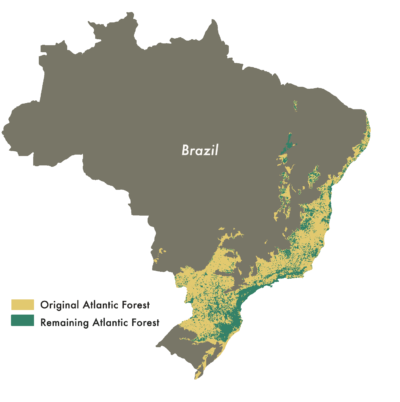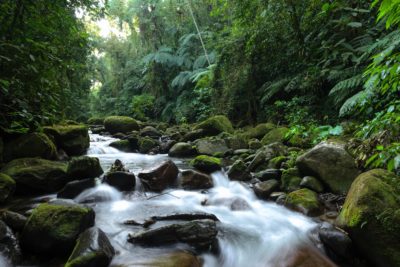It was 2016 when Jurandir Jekupe noticed the bees were gone.
Their nests were once common in Yvy Porã, the Guarani Mbya village where Jekupe grew up and still lives. But now the uruçu, a species known for its honey, had all but vanished, and sightings of the jataí, a species sacred to the Guarani Mbya, were rare.
“Bees are very sensitive,” says Jekupe, a leader in his Indigenous community. “They’re like a thermometer for the forest. If they disappear, you know there’s something wrong.”
Yvy Porã is one of six villages that make up the Jaraguá Indigenous Territory. It lies just 12 miles northwest of downtown São Paulo and is surrounded by the concrete of working-class neighborhoods. But this small forested area is part of a much larger whole — Brazil’s Atlantic Forest, a domain that covers almost 35,000 square miles, running along more than 1,800 miles of the Atlantic Coast, sweeping across 17 Brazilian states, and dipping into Argentina, Paraguay, and Uruguay.
Logging of this forest — still considered the second largest rainforest in Brazil — began in the early 16th century as land was cleared for timber and mines and then, in the 19th century, for coffee plantations, beef, sugar, firewood, and charcoal. Today, developers continue to clear the Atlantic Forest for housing, as the populations of São Paulo — currently home to 12.4 million people — and Rio de Janeiro explode.
Indigenous peoples in Brazil are widely regarded as land protectors, and a new study of the Atlantic Forest confirms it.
As the forest has fallen, so have populations of native bees. And without the pollination they provide, the forest that remains — in places like Yvy Porã — has struggled to survive.
So the Guarani Mbya decided to do something about it.
A nomadic people, they often travel to other villages within the forest, visiting family and exchanging information. On a trip in 2016, residents of Yvy Porã learned that villagers in the state of Espírito Santo, which had also lost its native bees, had started buying bees, raising them in wooden hives, and reintroducing them to their land. The Guarani Mbya decided to bring the idea back with them to São Paulo.
And it worked.
According to a study published in the journal Ecological Applications, the restoration and conservation of tropical forests in Brazil depends on plant species that rely on bees for pollination. While looking specifically at the Atlantic Forest, the researchers concluded that conserving bee populations should be a priority for forest restoration.
“There’s a difference now,” says Márcio Mendonça Boggarim, chief of Yvy Porã and its head beekeeper. “The bees are thriving and the plants we have been reintroducing to our land have been doing better, growing more.”
Left: Jurandir Jekupe of the Guarani Mbya tends to a beehive in the village of Yvy Porã in the Atlantic Forest. Right: An uruçu stingless bee in one of 110 beehives in Yvy Porã.
Jill Langlois
Both the trees and the bees, it turned out, needed a hand from the people who lived among them and had a deep connection to their land.
Indigenous peoples across Brazil are widely regarded as land protectors, and a new study of those living in the Atlantic Forest confirms it. Not only do Indigenous peoples push back against further attempts at deforestation, the study found, they also initiate projects to restore biomes like the Atlantic Forest, including the reintroduction of native bees and the planting of trees and other vegetation that were long ago wiped out by outsiders.
But like many other Indigenous groups living in the Atlantic Forest, the Guarani Mbya are working at a disadvantage. They lack financial support from outside their community and, most importantly, from the federal government, which has yet to grant them tenure to the entirety of their land, which on the Jaraguá Indigenous Territory covers some 1,315 acres. And without this official recognition, their efforts to raise money for restoration efforts are less effective than they could be, leaving the Atlantic Forest vulnerable to even more loss.
Added to the World Heritage List by UNESCO in 1999, the South-East reserves of the Atlantic Forest — and other parts of this biome — are home to well-known species like jaguars, sloths, golden lion tamarins, and toucans, in addition to lesser-known species like thin-spined porcupines and Bocaina treefrogs. According to the World Wildlife Fund, one hectare of Atlantic Forest can support 450 species of trees. Of its 20,000 vascular plant species, about 8,000 are endemic, meaning they occur nowhere else in the world.
“The Atlantic Forest has also been largely overlooked when it comes to Indigenous peoples,” says a researcher.
While an estimated 83 percent of the Amazon rainforest, which regularly makes headlines for its rampant deforestation, is still intact, only about 12 percent of the Atlantic Forest remains standing. It’s a percentage that worries scientists.
Most experts recommend maintaining 30 percent of forest cover to maintain biodiversity, says Rayna Benzeev, a postdoctoral research fellow at the University of California, Berkeley, who studies the restoration of tropical forests, with an emphasis on the Atlantic Forest. Once forest cover dips below that threshold, flora and fauna are at risk of disappearing.
Worldwide, Indigenous communities are increasingly seen as the best protectors of forests. According to the World Resources Institute, lands under Indigenous control in the Amazon suffer less deforestation than those outside Indigenous control and so tend to be net carbon sinks, rather than net carbon sources. And environmentalists increasingly acknowledge that forest communities often make better custodians of their forests than do formally protected national parks.
As part of a recent study published in the journal PNAS Nexus, Benzeev and her coauthors looked at 129 Indigenous lands in the Atlantic Forest. There, they found either less deforestation or increased reforestation where Indigenous people have formal rights to their land, compared with Indigenous communities that lack official rights to their land.
According to the study, each year after tenure was formalized, forest cover increased 0.77 percent compared with Indigenous territories that were untenured. It’s a finding that highlights the importance of granting formal land title to Indigenous communities in the forest.
“The Atlantic Forest has also been largely overlooked when it comes to Indigenous peoples,” says Benzeev, who carried out the study while receiving her PhD in environmental studies at the University of Colorado, Boulder. “But it is important to remember how many Indigenous lands and peoples there are in the Atlantic Forest,” which is also home to the majority of Brazilians, most of whom live in large urban centers.
For the Guarani Mbya living on the Jaraguá Indigenous Territory, land tenure has long been a complex and trying issue. On paper, the Indigenous group has tenure over just 4.2 acres of land, enough space for the 70 people living in Ytu, one of six Guarani Mbya villages. The rest of the 700 Guarani Mbya living on the territory, including those in Yvy Porã, occupy land for which they do not yet have official tenure. Once land is under the tenure of Indigenous peoples in Brazil, the federal government is required by law to protect it. If outsiders attempt to invade and deforest the land, authorities are required by law to remove them, although those laws have not always been enforced, especially during the recent administration of Jair Bolsonaro, who served as president from 2019 to 2022.
For decades, the Guarani Mbya have sought official tenure of their lands, but their petition has remained stalled.
The Guarani Mbya have, for decades, sought official tenure for the almost 1,315 acres they already live on; the government addressed their request most recently in 2015. Their petition went through most of the required steps, but then, like many other petitions for land tenure in Brazil, it stalled. All it needs now is a signature from President Luiz Inácio Lula da Silva and official registration.
During his election campaign, Lula, as the president is known, promised to sign land tenure decrees for all 237 pending requests from Indigenous peoples, saying it was “a moral commitment, an ethical commitment for those who are humanists, for those who defend Indigenous peoples.” His government has since said that tenure for the first 13 Indigenous territories will be finalized by the end of this month; the Jaraguá Indigenous Territory isn’t among those territories.
As the Guarani Mbya’s legal fight continues, so does their work to restore their piece of the Atlantic Forest. Some residents of the territory focus on removing invasive species from the forest: Coffee plants still run rampant on their land, displacing native species, and old plantations of eucalyptus have been causing problems too, sucking up too much water and leading to overly dry soil and erosion. The Guarani Mbya have been replacing these plants with native species like brazilwood, mate, and palmito juçara.
They’ve had to purchase seedlings and saplings, Jekupe says, chuckling at one small tree recently planted next to a grouping of beehives. It still has a price tag hanging from its thin trunk. “Forty-five reais,” he says as he turns it over in his hand. “Who would have thought we would have to pay for trees for our own land?”
Others work alongside Boggarim, the Yvy Porã chief, learning to care for the eight species of native bees he’s brought back to the village. The foot-tall wooden boxes with corrugated tin roofs stand on poles among the trees, each with a species-specific opening in its front where bees, all stingless, zip in and out. He has placed their 110 hives in groupings around Yvy Porã, a strategic plan to make sure the bees and the forest can help each other equally.
“Protecting our territory, reforestation, raising native bees: It’s all one job,” says Boggarim. “We can’t think of them as individual tasks. Without one, we can’t have the others.”
Boggarim’s father and grandfather first taught him about the importance of the insect to the forest and their culture. The jataí’s wax, for instance, is turned into candles used in Guarani Mbya naming ceremonies and for making other sacred objects essential to their prayer houses. Now Boggarim passes that information to younger generations, along with what he’s learned from other beekeepers about how to monitor the insects and make sure they are healthy and thriving.
“If we want to save the forest, we need the government to officially recognize that this is our land.”
Boggarim has helped bring bees into five villages on the Jaraguá Indigenous Territory and has plans for a sixth, and he’s thinking about how they can start producing and selling honey. It would not only provide local families with much needed income, but would also help them share their culture and the importance of the forest with people outside their community.
Already, the Guarani Mbya work with schools to provide educational tours on their land. But without tenure for all of their land, it’s been a struggle to get some projects off the ground.
For example, Jekupe explains, most of their projects require resources to be shipped in from out of state — their bees came from the Guarani Mbya village in Espírito Santo, some 705 miles away, and some of their plants came from as far as Rio Grande do Sul, Brazil’s most southern state. Funding for these projects often comes from NGOs and government bodies, but in the absence of land tenure, some donors shy away from these projects, worried that bureaucracy and conflicts could bring them to a halt.
“If we want to save the forest, we need the government to officially recognize that this is our land,” says Jekupe. “We’re the ones who see the consequences of deforestation, who feel the consequences of climate change, every single day. And if they step out of the way, we’re the ones who can do something about it.”




